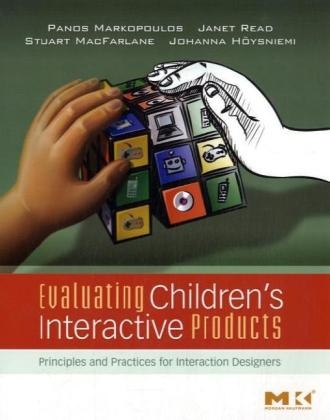Ulteriori informazioni
Klappentext If you remember the movie Big, with Tom Hanks, then you'll recall that it takes a child to tell you what's fun--particularly when it comes to toys and games. This book is about design and testing of software and other technology for children--whether it is toys, games, or educational products. The methods include children as design partners, and because of this and the products themselves, require a different set of methods and tools to get the job done. This book is a complete short course on how to do that: what is different about designing for children and how to do it: with principles and rules, guidelines and tips, and lots of case studies and quizzes to help get a thorough understanding. An invaluable tool for a designer or usability professional entering the world of chilren's products, as well as a good set of tools for the experienced children's designer. Zusammenfassung Interactive products designed for children are increasingly embedded in children's lives and school experiences. Making these products safe! effective! and entertaining requires new methodologies for carrying out unbiased evaluations. This book addresses this need by covering the evaluation of various types of interactive technology for children. Inhaltsverzeichnis PART 1 CHILDREN AND TECHNOLOGY 1 WHAT IS A CHILD2 CHILDREN AND INTERACTIVE TECHNOLOGY 3 THE INTERACTIVE PRODUCT LIFECYCLE PART 2 EVALUATING WITH AND FOR CHILDREN 4 ETHICAL PRACTICE IN EVALUATIONS 5 PLANNING THE EVALUATION STUDY 6 BEFORE THE EVALUATION 7 DURING THE EVALUATION 8 AFTER THE EVALUATION PART 3 METHODS OF EVALUATION 9 RECORDING AND LOGGING 10 OBSERVATION METHODS 11 VERBALIZATION METHODS 12 THE WIZARD OF OZ METHOD 13 SURVEY METHODS 14 DIARIES 15 INSPECTION METHODS PART 4 CASE STUDIES 16 CASE STUDY 1: GAME-CONTROLLING GESTURES ININTERACTIVE GAMES 17 CASE STUDY 2: EMBEDDING EVALUATION IN THEDESIGN OF A PERVASIVE GAME CONCEPT 18 CASE STUDY 3: USING SURVEY METHODS AND EFFICIENCY METRICS...
Sommario
PART 1 CHILDREN AND TECHNOLOGY1 WHAT IS A CHILD2 CHILDREN AND INTERACTIVE TECHNOLOGY 3 THE INTERACTIVE PRODUCT LIFECYCLE PART 2 EVALUATING WITH AND FOR CHILDREN4 ETHICAL PRACTICE IN EVALUATIONS 5 PLANNING THE EVALUATION STUDY 6 BEFORE THE EVALUATION 7 DURING THE EVALUATION 8 AFTER THE EVALUATION PART 3 METHODS OF EVALUATION9 RECORDING AND LOGGING 10 OBSERVATION METHODS 11 VERBALIZATION METHODS 12 THE WIZARD OF OZ METHOD 13 SURVEY METHODS 14 DIARIES 15 INSPECTION METHODS PART 4 CASE STUDIES16 CASE STUDY 1: GAME-CONTROLLING GESTURES ININTERACTIVE GAMES 17 CASE STUDY 2: EMBEDDING EVALUATION IN THEDESIGN OF A PERVASIVE GAME CONCEPT 18 CASE STUDY 3: USING SURVEY METHODS AND EFFICIENCY METRICS
Relazione
"Evaluating Children's Interactive Products provides numerous practical suggestions based on the authors' considerable experience and wisdom. The authors present a powerful case for the importance of beginning the evaluation process by spending time with children and attempting to see the world through their eyes. The emphasis on the often overlooked aspects of evaluation, ,is refreshing and makes this book a "must read” for anyone truly dedicated to providing valuable insight on behalf of children and improving the products intended for their use." --Kristin Alexander, Group Research Manager, Microsoft"Evaluating Children's Interactive Products gives a great introduction to a wide range of methods for working with children. It is an excellent resource for students and researchers alike." --Dr Judy Robertson, Lecturer, Computer Science, Heriot-Watt University."There is nothing more important than improving the lives of children. This book offers a way for industry professionals and academic researchers to understand the needs of young people, which can lead the way to better new technologies. There is a wealth of information, experience, and inspiration that the authors share that will ask you to first consider, or spend some time re-examining, what is possible and important for children." --Allison Druin, Director, Human-Computer Interaction Lab, Associate Professor, University of Maryland"Evaluating Children's Interactive Products fills a void in the literature by providing practical advice based on the authors' experience, a thorough survey of evaluation methods, as well as valuable real world examples. It brings together valuable information and experiences that would have previously required reading dozens of papers and several books. The authors have been heavily involved in the interaction design and children research community and it shows in the breadth and depth of topics covered, and in the content being up-to-date. This is a useful book for people in industry and for researchers in academia who are interested in conducting evaluations of technologies for children. The writing style is easy to follow and appropriate for native speakers of English as well as for those who are fluent in English but for whom English is a second language." --Juan Pablo Hourcade, Assistant Professor, Department of Computer Science, University of Iowa

